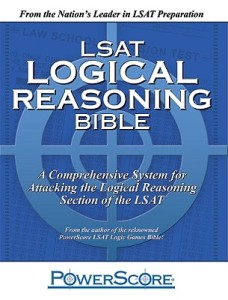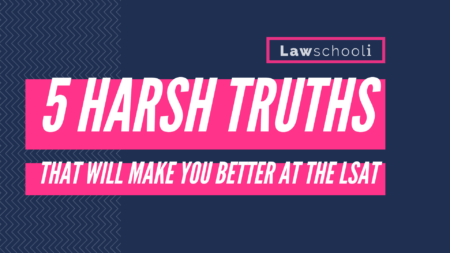Sometimes, it’s tough for me to remember what it was like to begin studying for the LSAT. At first, the whole thing was totally foreign to me.
In recognition of that, we wanted to do a post for those just starting out learning logical reasoning (LR) in order to help you get a hold on the fundamentals of the section.
Heads up, this will cover pretty basic info, so those of you who have some LSAT experience might want to scan to the bottom to find our posts on more advanced LR topics.
The LSAT LR Section – Fundamentals
There are two scored logical reasoning sections on each LSAT, out of a four total scored sections of the LSAT. Each section just has LR questions, and nothing else. Together, these two sections will add up to approximately half the total questions on the LSAT (A typical LSAT has 100-103 questions).
This makes performing on the logical reasoning section relatively more important than reading comprehension or logic games, which each get just one scored section (the fifth section on the LSAT is an experimental section which is not scored. This can be either an LR, RC, or LG section. Unfortunately, you don’t know which section is the experimental while you are taking the test. Read here for more info on figuring out which section is the experimental after the test).
Each logical reasoning section contains 24-26 questions and you are given 35 minutes to complete each section. That leaves an average of one minute and twenty-five seconds to do each question. However, don’t even try to spend exactly that amount of time on every single one — that’s not how it works.
The first ten questions of the section are generally easier and can be done more quickly than the back end questions. Developing the sense of pacing to spend the appropriate amount of time on each LR question is one of the hardest parts of learning the section.
For now, the important thing to know is that timing is a major issue for nearly everyone tackling the LSAT. Given infinite time, these questions really wouldn’t even be all that hard. You may not believe me if you’ve tackled only a handful of questions thus far, but these problems do make sense. There are concrete strategies that can get you to a right answer with nearly 100% confidence.
However, because of the time pressure, this section is going to strain your reasoning skills and reading skills to the utmost. Let’s take a good hard look at the “enemy”, and see what a real LSAT question looks like.
Sample Logical Reasoning Question
Here is a sample question from a free LSAT test that LSAC (the makers of the test) have made available for practice:
An undergraduate degree is necessary for appointment
to the executive board. Further, no one with a felony
conviction can be appointed to the board. Thus,
Murray, an accountant with both a bachelor’s and a
master’s degree, cannot be accepted for the position of
Executive Administrator, since he has a felony
conviction.The argument’s conclusion follows logically if which
one of the following is assumed?(A) Anyone with a master’s degree and without a
felony conviction is eligible for appointment to
the executive board.(B) Only candidates eligible for appointment to the
executive board can be accepted for the
position of Executive Administrator.(C) An undergraduate degree is not necessary for
acceptance for the position of Executive
Administrator.(D) If Murray did not have a felony conviction, he
would be accepted for the position of
Executive Administrator.(E) The felony charge on which Murray was
convicted is relevant to the duties of the
position of Executive Administrator.[source]
Anatomy of An LSAT LR Question
As you may have guessed, you have to pick one, and only one of those answers, but what else is going on? The first part of the question is called the stimulus (from “an undergraduate degree…” to “…since he has a felony conviction”). let’s look at that:
The Question Stimulus
The question stimulus ALWAYS does one of two things: it either presents an argument or a set of facts.
Arguments do just what you might imagine, which is argue for something. They will always have a conclusion — some main point that the passage author is trying to advance — which is supported to one degree or another by some other statements. Arguments can, and on the LSAT often will be, massively flawed. However, they all share the same common features of a conclusion that purportedly follows from some other supporting statements, called premises.
I will do a full post on identifying premises and conclusions later this week (sign up below to get it straight to your inbox), but for now, you just need to know simply that a conclusion is the point the argument is trying to make, the main statement or judgment they are trying to get across. Premises on the other hand, are the stuff that supports that statement. All arguments consist of at least one premise and one conclusion.
One of your primary goals on the LSAT is to dissect and analyze the strength of the arguments. Let’s look at the above stimulus: the main point is that Murray cannot be accepted for the position of Executive Administrator.
However, the argument appears incomplete. Did you spot that? We only know that he can’t be on the board. He would be qualified, but he’s got this nasty felony conviction, so he’s not eligible. But why can’t he be the Executive Administrator? We don’t know that a felony disqualifies you for that. As it stands, this argument’s conclusion doesn’t follow logically from it’s premises. You will asked to find something that can tie these premises to that conclusion.
Incomplete arguments like this are a common feature on the exam. As you learn from your LSAT prep books or your prep class, you will get really good at evaluating arguments and know whether they are sound and valid. It’s actually, believe it or not, a lot of fun. The best attitude to take into the LSAT is that of being a smart-ass private detective (or a lawyer, for that matter). People are trying to feed you all this info, and some of it is meant to trick you and trip you up. You have to decide what’s good and what’s total BS. Luckily, there are a lot of rules to help you. If you feel you know the basics already, get started here with a free lesson on conditional reasoning.
Set of facts questions, on the other hand, just give you some neutral information in the stimulus. No argument is being made. These are much more rare than argument type questions. Sometimes you get a whole LR section without one. Don’t worry however, they certainly aren’t naturally harder or anything like that. They just don’t make an argument. You are given some facts straight up and will have to do some logical task using them.
The Question Stem
The question stem here is the part in our example question that asks “the argument’s conclusion follows logically if which one of the following is assumed?” I want to tell you up front that there is a big debate in LSAT prep about whether you should read the question stimulus or stem first. We are 100% on the side of reading the stimulus (the longer part) first. Trust me, it’s the way to go. We make our full case for stimulus first HERE.
The question stem is basically your friend. Until you read it, you may not even have spotted that the argument above is an incomplete argument. If your brain accidentally changed the words “Executive Administrator” to “Executive Board Member”, the conclusion would seem follow logically from the premises. However, the stem here would wake you up and tell you that, no, the argument is incomplete and you have to find something that makes the conclusion follow logically.
Take a look and try to solve the problem on your own. If you are having difficultly, read our post on mastering sufficient assumption questions, then come back and try it. I guarantee you’ll be able to solve it at that point.
Now, if you are back with me, you may have figured out the answer. If you chose B, then you got it. You are off to a good start.
See how that fits the other premises to the conclusion? If you have a felony —> then you can’t be on the board. Murray has a felony —> therefore, he can’t be on the board. Now add B: if you aren’t on the board —-> then you can’t be the EA. Therefore Murray can’t be the EA. The conclusion follows.
If that seems hard, don’t worry about it now. Learning the LSAT is a process of doing reasoning like this over and over again until it becomes second nature. With work and dedication, you can make this stuff come quickly and naturally, I promise. Skill on the LSAT can come with hard work even if you don’t start out with a ton of natural ability. I’ve seen it done, countless times.
LR Fundamentals: Question Types
When you first look at an LR section without knowing what’s up, it looks like there are just an infinite number of different kinds of questions. That’s just an illusion to scare you. The reality is that these questions fall into patterns that just repeat themselves over and over again.
The absolute key to achieving logical reasoning mastery is to get the skills you need to handle these types and learn how to apply the skills to each one. For example, that sample question is what’s called a “sufficient assumption” question. Somewhere between one and four questions on each LSAT LR section will be just like that. No, they won’t be about Murrays and executive boards — the subject matter of LSAT questions is basically infinitely varied — but the form of the question will be just like this one: you’ll have some premises and a conclusion and will have to find another premises that links the other premises to the conclusion.
Luckily for you, the question stem is always basically the same for a given question type. That makes question types easy to spot. So on sufficient assumption questions, you are going to see something like this in the question stem:
The conclusion follows logically from the premises if which one of the following is assumed
The conclusion is properly drawn if which one of the following is assumed?
The conclusion of the argument is properly inferred if which one of the following is assumed?
Trust me, recognizing question types is the easy part. If you are curious about how to spot and solve sufficient assumption questions, here is a free sufficient assumption question lesson.
Learning Question Types and Techniques
My philosophy of LSAT LR study is that you want to be really focused in on the question types, learn to understand them inside and out, and practice them in a very directed manner. Despite all that scary talk about speed earlier, you are not even going to be thinking about timing the questions for a while when beginning your prep. First we are going to worry about accuracy.
Start with the LSAT Logical Reasoning Bible, the book Josh and I both used on our way to getting none wrong on the logical reasoning sections. The most effective way to use it is in tandem with the Powerscore Logical Reasoning Workbook, which gives you further practice on different question types using real LSAT questions.
I really love the idea of doing workbook this BEFORE you ever do a full LR section, where all the different question types are mixed together. Trust me, it’s enough for your brain to handle to learn one of these section types at a time. This way, you’ll progress faster and won’t feel overwhelmed.
Click Here to add the LR Bible & Workbook To an Amazon Shopping Cart
Now, we also have a ton of other advice to help you with mastering the LR section. This post should help with trouble shooting and let you know what the process of getting better looks like in detail:
Why You Aren’t Getting Better At Logical Reasoning (Yet)
Here are some more specific LR topics, covering some of the primary question types:
LSAT Logical Reasoning Lessons
Thanks for reading and be sure to follow us for much more free logical reasoning advice and support. Sign up for our email list below to get the posts (and nothing but the posts) straight to your email. Also check us out on twitter @onlawschool. If you have any questions at all about prepping for the LSAT, just ask here or in the new Q+A!
Good luck and enjoy developing some new skills!





3 Comments
Thanks for an awesome post! I noticed you mentioned that you would do a full post on identifying premises and conclusions and wondering where might be the best place to find your explanation? I am still having rough spots identifying between the two.
For example: Astorga’s campaign promises are apparently just an attempt to please voters. What she says she will do if elected mayor is simply what she has learned from opinion polls that voters want the new mayor to do. Therefore, voters are not being told what Astorga actually intends to do if she becomes mayor.
For LG, if, for example, A is next to B, does that mean AB and BA or just BA?
For LR and LG, how is “neither A nor B” diagrammed?
Thanks!
Yes, it does mean AB or BA is possible unless they specify the order.
I always diagram that as “-A and -B”
…so if you had a hypothetical rule “if neither A or B are in, then C is in” would be diagrammed: -A and -B —-> C